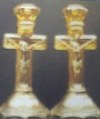Carnival Glass 101 | home Quick Reference to Carnival Glass Patterns on This Site
Westmoreland - Part 7
WESTMORELAND - Part 7
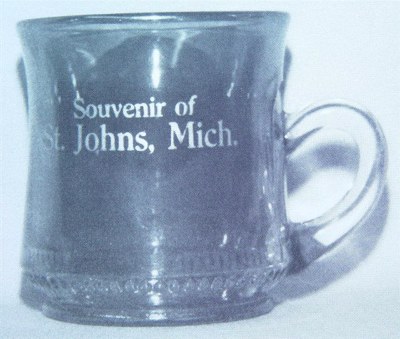
Small Thumbprint Mug
SMALL THUMBPRINT Mug: This Souvenir mug is in good marigold and was included in the John & Lucile Britt collection at one time. Similar in size to the Estate mug, standing only 3” tall, with a top opening of 2 ¾”. A 24 point star figure is pressed into the underside of the base. A band of tiny sunken ellipses encircles the mug near the base. The lettering was applied with stencil application, appearing on only one side of the mug. It has a molded clear glass handle. Souvenir glass was very popular around the turn of the century when tourist travel was developing. It extended into the carnival glass era.
A Souvenir creamer in this Small Thunbprint pattern is described and sketched in Hartung Book 7-page 82. Wm. Heacock called the pattern Tiny Thumbprint in his book called Custard Glass From A-Z. The custard pieces were made by Tarentum Glass Company of Tarentum, PA. Since we do not know who may have created the iridized examples, nor who may have purchased the molds from Tarentum Glass Co., we have decided to “tentatively” place this photo and the bit of information about it, within the Westmoreland framework until such time as we can ascertain better placement. Should any of our readers have some concrete information surrounding these pieces, we would be delighted to hear from you!
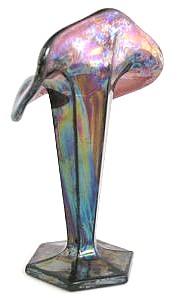 |
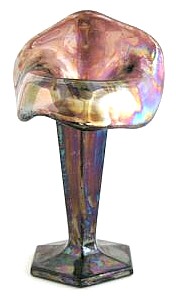 |
COLONIAL Lily Vase - #1700 - 6 1/2 in. tall - 2 1/2 in. base.
|
COLONIAL Lily Vase -Amethyst-#1700
|
KEYSTONE COLONIAL: Westmoreland is responsible for creating this very unusual design. At least three of these have been reported in iridized purple, all with the Keystone trademark containing a “W”. A lavender one brought $100 in a 1990 auction. NOTE: The Keystone trademark using the “W” was used between 1910-1920. There are pastel blue, crystal, and amber-gold reproductions of this piece. These are not iridized.
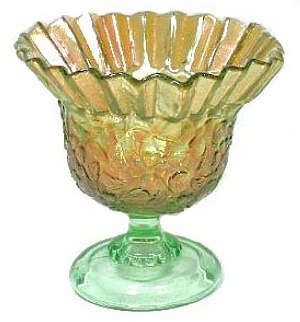 |
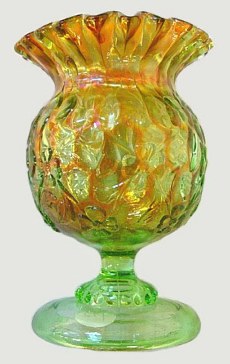 |
DAISY SQUARES -
5.5 in. tall.Light Green
|
DAISY SQUARES Rosebowl shape.
|
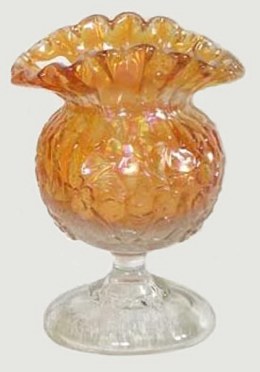 |
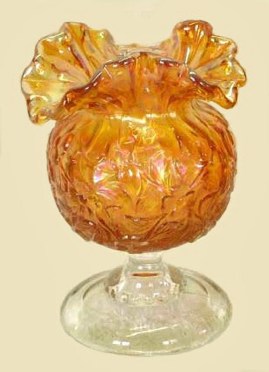 |
DAISY SQUARES Rose Bowl.
in Marigold
|
DAISY SQUARES Rose Bowl
with Tri-Corner top
|
DAISY SQUARES: Our display of photos offers a wide array of top edge treatments. Additional colors known in this pattern are a deeper green shade in the compote, along with amber found occasionally in a flattened compote. Probably the most unusual color in the pattern is amethyst. It can appear in either the compote or rose bowl shape. Far more scarce than many Northwood patterns, yet this Daisy Squares pattern seldom brings more than $500 in any shape or color! We believe the reason to be that it is so seldom seen. Perhaps many collectors never have the opportunity to purchase an example.
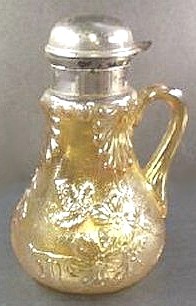
Wild Rose syrup - Found in Marigold.
We have seen a round marigold bowl with plain interior
for sale on Ebay, said to have this same exterior pattern
WILD ROSE Syrup: This 6 ½” rarity is very difficult to obtain. During a five year period of active carnival glass auctions, an average of four or five are the extent of sales. Color is confined to marigold, and many examples are quite pale in color. The metal tops usually show tremendous wear. Depending upon the condition overall, some have sold for as little as $100, with better examples reaching $1000.
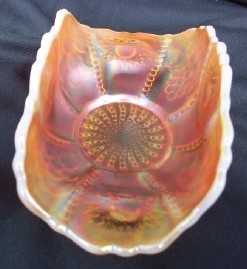 |
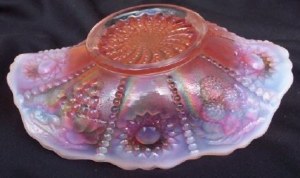 |
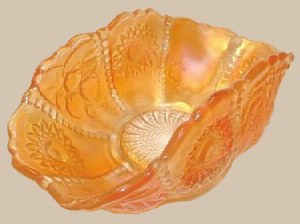 |
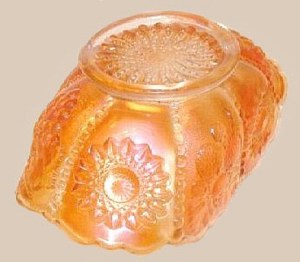 |
HOBSTAR & FRUIT Banana Bowl - Mgld.- 5.5 x 3 x 2.25 inches.
|
|
HOBSTAR & FRUIT: The banana boat shape is quite desirable in this pattern and they are not seen as often as the ruffled sauce shape (Not that any examples in this pattern are readily available). If a complete collection of Westmoreland carnival glass were attempted, it would require the years of a lifetime to accumulate, we venture to say. Marigold, Peach Opal, Blue opal, Moonstone are the colors known in this pattern.
(Click on ~~ ~~ in our pattern alphabet - homepage, for a look at the Blue opal sauce in this pattern.)
~~ in our pattern alphabet - homepage, for a look at the Blue opal sauce in this pattern.)
Dean and Diane Fry - 10/07
 |
|
Here, Paul warns that one of the characteristics of the endtimes will be the acceptance of heresies and falsehood.
(1 Tim. 4:1-2, 2 Tim. 3: 1-7)
I charge you therefore before God and the Lord Jesus Christ,
who will judge the living and the dead at His appearing and His kingdom: Preach the word! Be ready in season and out of season. Convince, rebuke, exhort, with all longsuffering and teaching. For the time will come when they will not endure sound doctrine, but according to their own desires, because they have itching ears, they will heap up for themselves teachers;
and they will turn their ears away from the truth, and be turned aside to fables. But you be watchful in all things, endure afflictions, do the work of an evangelist, fulfill your ministry.
~~~ 2 Timothy 4: 1-5
|
|
 |
Should you care to contact the Frys, their email address is:
Search Carnival Glass 101
back to Carnival Glass 101
Our other sites you may enjoy:
Everything you EVER wanted to know about Indiana Glass
Great Reference for Newer Carnival Glass.
Complete Glassware Catalogs Available to Download
Questions? Comments? Suggestions? Broken Links? Corrections?
Your Friendly Webmaster is here to help!
